By Maryam Khoshoei, AIWC Cologne, FAWCO Youth
Maryam participated the 3rd FAWCO Youth Cultural Volunteers Program traveling to Mumbai, India in the summer of August 2015. Today, Maryam is 20 years old and studying Gender and Diversity at the Rhine-Waal University of Applied Sciences in Cleves.
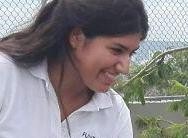 Living abroad has been a life changing experience for me. I was born in the UK and raised in Germany. My mother is Colombian and my father Iranian. Growing up with four different cultures and languages, including two religions (Catholicism and Islam) has impacted my daily life. Being raised in a multicultural and multilingual home, is what has aroused my interests in culture, languages, travelling and international relations.
Living abroad has been a life changing experience for me. I was born in the UK and raised in Germany. My mother is Colombian and my father Iranian. Growing up with four different cultures and languages, including two religions (Catholicism and Islam) has impacted my daily life. Being raised in a multicultural and multilingual home, is what has aroused my interests in culture, languages, travelling and international relations.
Life as a “third culture kid” has brought me many benefits. I speak English, German, Spanish and Farsi. At home we usually speak English. Sometimes my mother and I speak Spanish, just to keep in practice. Having both parents come from developing countries whilst growing up in the richest country of Europe, had always had quite an influence on my passion for travelling, exploring new traditions and adapting to many cultures at the same time. It even made me feel obligated to somehow contribute to my homelands. After my studies, I hope to be able to work for an NGO and work as a sociologist and activist to tackle the fight against extreme poverty and slum buildings.
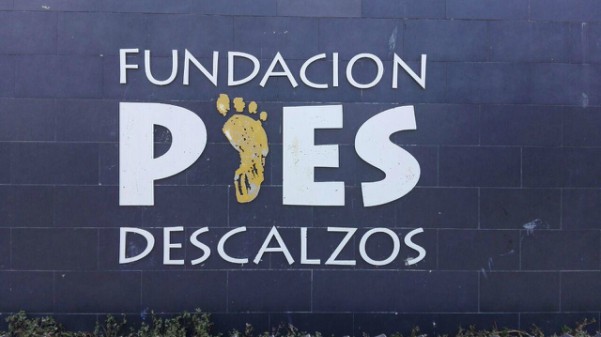 In July 2016, right after my high school graduation, I flew to Colombia where I travelled around the country for a month and worked for a non-profit organization called “La Fundacion Pies Descalzos” (Barefoot Foundation), which was founded by the Colombian singer Shakira in 1997. Four schools have been built throughout Colombia in cities such as Barranquilla, Cartagena, Quibdo and Soacha. The schools are public institutions that provide children and teenagers education, spaces and activities for families and communities to spend time together. More than 10,000 children and 67,000 youths and adults have benefited from the programs provided.
In July 2016, right after my high school graduation, I flew to Colombia where I travelled around the country for a month and worked for a non-profit organization called “La Fundacion Pies Descalzos” (Barefoot Foundation), which was founded by the Colombian singer Shakira in 1997. Four schools have been built throughout Colombia in cities such as Barranquilla, Cartagena, Quibdo and Soacha. The schools are public institutions that provide children and teenagers education, spaces and activities for families and communities to spend time together. More than 10,000 children and 67,000 youths and adults have benefited from the programs provided.
Taxi to School - Walking is not an option or at least a very risky one
The school I volunteered in is located outside the city of Cartagena, right by the Caribbean coast and was built in 2011. The city is divided into two parts: The touristic rich old city area and the marginalized slum area. The students’ ages range from 5 years to 19 years. Classes for preschoolers are also available for children at the age of three to five years. Apart from education and educational material, the school provides free lunches and snacks, sports activities and psychological counseling for students and parents.
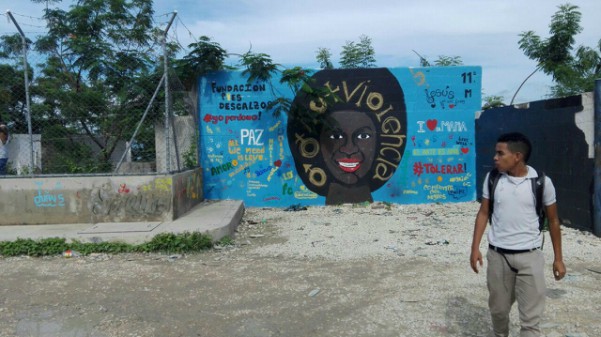 During my stay in Cartagena I stayed with a very warm-hearted Colombian host family, who within just hours made me feel not only more than welcome but like I was part of the family- talk about hospitality!
During my stay in Cartagena I stayed with a very warm-hearted Colombian host family, who within just hours made me feel not only more than welcome but like I was part of the family- talk about hospitality!
It took about 20 minutes to reach the school by car. The area in which the school is located is very isolated from the mid-upper class since it is hit by poverty and influenced by the active informal sector. The marginalized area called “El Barrio La Maria” also has its reputation of having its high rates of crimes carried out by mostly teenagers. Reaching the school was not very easy because of its dangers of violence. The school is constantly surrounded by security and armed soldiers who wander around the neighborhood to keep order. The students are all from the same area and have to walk up the hill to reach the school. Yet children are no target in these areas.  On my first day the doorman told me how previous volunteers and even local teachers, who came by car, have been stopped by armed young teenagers and robbed. Due to the high risk of being robbed and lack of public transportation, I had to reach the school by taxi. At first I did not like the idea of going to work for an NGO by taxi, especially as you can tell I am not fully Colombian. Later I found out that this is how everyone reaches the school, either by taxi, mototaxi or car. Some taxi drivers sometimes refused to enter the “Barrio La Maria” for safety reasons. Walking is not an option or at least a very risky one.
On my first day the doorman told me how previous volunteers and even local teachers, who came by car, have been stopped by armed young teenagers and robbed. Due to the high risk of being robbed and lack of public transportation, I had to reach the school by taxi. At first I did not like the idea of going to work for an NGO by taxi, especially as you can tell I am not fully Colombian. Later I found out that this is how everyone reaches the school, either by taxi, mototaxi or car. Some taxi drivers sometimes refused to enter the “Barrio La Maria” for safety reasons. Walking is not an option or at least a very risky one.
It was Finally My Turn to Teach!
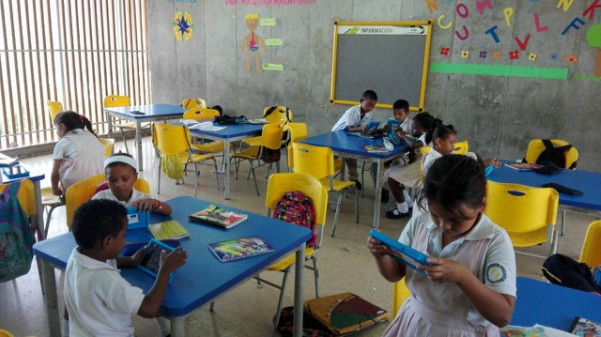 On my first day I met with the directors and all the teachers who welcomed me and showed me around the school. They introduced me to the classes I was about to be teaching within the next few days after I had observed the classes and taken notes in order to prepare my own lessons. My job was to teach English to first and second graders and assist some teachers in their classes, whether it was Math class, Castellano (Spanish), Biology or Social lessons. I started each day at 7 am, which meant I had to get up at 5 am to arrive on time because of the traffic - nothing compared to the traffic I faced in Mumbai back in August 2015 though. Wednesdays were my days of ‘Planeacion” which means that I spent the day starting at 9am and finishing at 1pm, planning my lessons, looking for material and exercises in the library and making up games to teach vocabularies in playful ways. The books in the library are all donated and in very good shape for students to borrow any time.
On my first day I met with the directors and all the teachers who welcomed me and showed me around the school. They introduced me to the classes I was about to be teaching within the next few days after I had observed the classes and taken notes in order to prepare my own lessons. My job was to teach English to first and second graders and assist some teachers in their classes, whether it was Math class, Castellano (Spanish), Biology or Social lessons. I started each day at 7 am, which meant I had to get up at 5 am to arrive on time because of the traffic - nothing compared to the traffic I faced in Mumbai back in August 2015 though. Wednesdays were my days of ‘Planeacion” which means that I spent the day starting at 9am and finishing at 1pm, planning my lessons, looking for material and exercises in the library and making up games to teach vocabularies in playful ways. The books in the library are all donated and in very good shape for students to borrow any time.
Every day after I finished classes, I would teach an 11-year-old girl in her sixth grade English for two hours. She was in need of intense English lessons. At first she was very shy and quiet. Yet after a few days of teaching and getting to know her better she gained trust in me and opened up like a flower blossom in the spring. I began to think of more fun ways to teach her through quizzes and games to keep her motivated and focused on our work. After long hours of teaching in the very hot weather, I decided to do some yoga exercises and run a few rounds around the school with my student so that we would both just take some deep breaths and regain our strengths to be able to concentrate for another two hours. At the end of each lesson we played a game of her choice for about 15 minutes, followed by a very warm hug to say goodbye. She normally accompanied me to the gates of the school and we chatted before we left to our separate homes for the day.
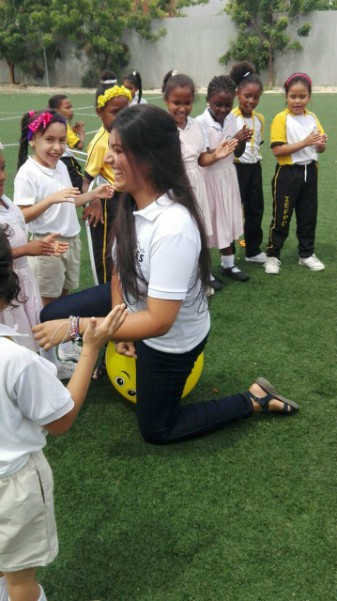 After a few days of observing the first and second graders in classes it was finally my turn to teach. I already had my agenda and material approved by the teacher... All of the teachers of the younger classes were female. Every class started the day at 7am with a prayer. The school is Catholic and run by a priest. Masses took place for the older students about twice or three times a week. The younger students of my classes had to close their eyes and repeat a prayer the teacher would conduct.
After a few days of observing the first and second graders in classes it was finally my turn to teach. I already had my agenda and material approved by the teacher... All of the teachers of the younger classes were female. Every class started the day at 7am with a prayer. The school is Catholic and run by a priest. Masses took place for the older students about twice or three times a week. The younger students of my classes had to close their eyes and repeat a prayer the teacher would conduct.
Some of the children would continue playing around without the teacher noticing whilst others would take it seriously and pray. After their prayer the teacher kindly let me take over the class. I always started by writing the date and the agenda on the board and let them copy it into their little workbooks. I always had a set of vocabularies ready to teach starting with animals then colors, professions, family, the body, the face, numbers, and classroom objects. First I wrote down the English word on the board along with the Spanish translation and let them copy everything. Then they repeated every word after me until they could associate the English word with the Spanish one fast enough and get the vocabularies in their heads.
Half The Class Was Missing on Mondays
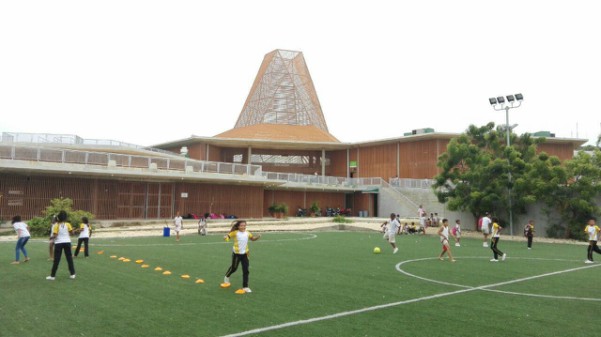 One task could take up to two whole days of class because of the lack of discipline and concentration. It took a lot of patience and strength to get the class to pay attention and keep quiet. Although I was aware of the fact that children are in desperate need of fun ways to learn, copying words and learning them first was the only way we could move on to games. Only then could I start playing educational games with them, which were more than a delight, not just for them but for me too. Playing games of memory (with an English word and a matching picture) or puzzles or drawing according to my description based on the words we learned brought so much joy and excitement to the class. I could tell how fast they learned and how much fun they had while doing so.
One task could take up to two whole days of class because of the lack of discipline and concentration. It took a lot of patience and strength to get the class to pay attention and keep quiet. Although I was aware of the fact that children are in desperate need of fun ways to learn, copying words and learning them first was the only way we could move on to games. Only then could I start playing educational games with them, which were more than a delight, not just for them but for me too. Playing games of memory (with an English word and a matching picture) or puzzles or drawing according to my description based on the words we learned brought so much joy and excitement to the class. I could tell how fast they learned and how much fun they had while doing so.
Unfortunately, I have witnessed families living in terrible conditions and extreme poverty. As most students are from these families, discipline is something that is hardly ever taught. It was normal that about half of the class was missing on Mondays because parents would spend their weekends drinking and did not send their children to school. Children, especially boys are often told to handle conflicts through violence. I had often witnessed many fights between the students in and outside of class. It was very heartbreaking to see how most of my students face these issues every day. Luckily the school offers psychological support for all students and family members. Besides that, the relationship between the students and teachers and even directors and coordinators is really touching. They are very close and can talk about everything. The teachers are always there for them and help their students in any way they can. Anyone witnessing their conversations would think they are mothers with their own children. At least the students always have someone to talk to when they are troubled.
It may seem frustrating and troubling to know about all the negative impacts poverty can have on the ability to teach in the slums. Yet there is a reason why Shakira decided to build her school in “El Barrio La Maria”. Education is the key to tackle poverty. If we are able to teach our children how to grow, live, and provide for themselves, by simply sending them to school and tutoring, we will be able to win the fight.
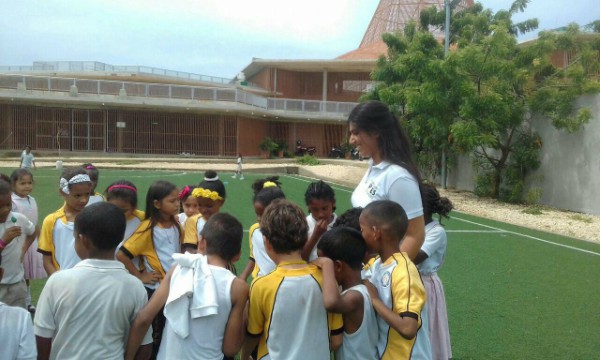 Saying Goodbye…was the hardest thing I had ever done
Saying Goodbye…was the hardest thing I had ever done
It was an honor to be able to work for the “Fundacion Pies Descalzos” and gain the most valuable experience of my life. Having made so many friends with the teachers, trainees, directors and of course students, saying “Goodbye” to my students, especially my English student I taught every day and have gotten to be very close with, was the hardest thing I had ever done.
Maryam Khoshoei, AIWC Cologne, FAWCO Youth
